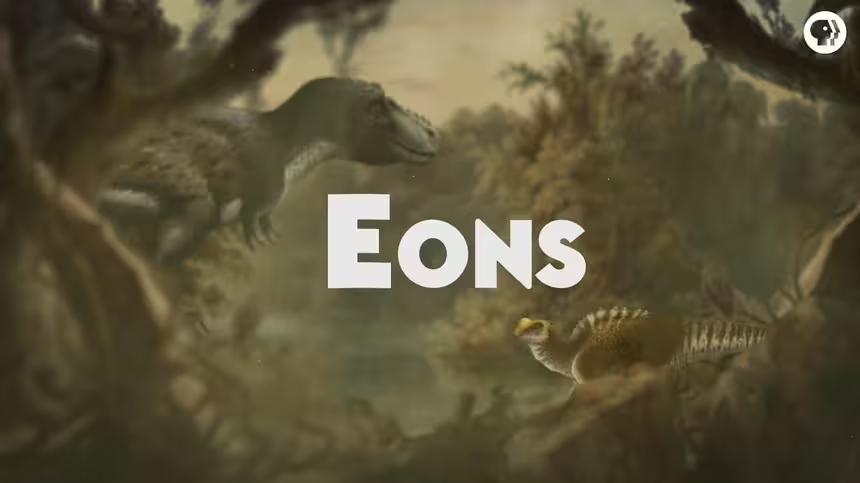
The Biggest Thing That Ever Flew
Season 1 Episode 8 | 4m 27sVideo has Closed Captions
Today, we’re familiar with two types of flying vertebrates -- birds and bats.
Today, we’re familiar with two types of flying vertebrates -- birds and bats. But over 66 million years ago, there was a giraffe-sized reptile that soared through the sky.
Problems playing video? | Closed Captioning Feedback
Problems playing video? | Closed Captioning Feedback

The Biggest Thing That Ever Flew
Season 1 Episode 8 | 4m 27sVideo has Closed Captions
Today, we’re familiar with two types of flying vertebrates -- birds and bats. But over 66 million years ago, there was a giraffe-sized reptile that soared through the sky.
Problems playing video? | Closed Captioning Feedback
How to Watch Eons
Eons is available to stream on pbs.org and the free PBS App, available on iPhone, Apple TV, Android TV, Android smartphones, Amazon Fire TV, Amazon Fire Tablet, Roku, Samsung Smart TV, and Vizio.

Welcome to Eons!
Join hosts Michelle Barboza-Ramirez, Kallie Moore, and Blake de Pastino as they take you on a journey through the history of life on Earth. From the dawn of life in the Archaean Eon through the Mesozoic Era — the so-called “Age of Dinosaurs” -- right up to the end of the most recent Ice Age.Providing Support for PBS.org
Learn Moreabout PBS online sponsorshipImagine an animal the size of a giraffe ... that could fly.
Wouldn't that be amazing?
Majestic?
Maybe a little terrifying?
Well, keep that image in mind, because over 66 million years ago, there was a giraffe-sized reptile/ that soared through the sky.
Today, we're familiar with two types of flying vertebrates -- birds and bats.
But back in the Mesozoic Era, there was another kind of flying animal -- pterosaurs, cousins of dinosaurs who flew on wings of leathery skin.
They were actually the very first vertebrates to take to the air.
Pterosaurs came in lots of sizes, the smallest being about the size of a brown bat.
But the biggest was so huge that paleontologists have been debating for decades about how such an enormous animal could actually fly.
The modern story of this flying giant starts in 1971, when geology student Douglas Lawson stumbled across the fossil bones of an enormous creature in Big Bend National Park, in Texas.
Those remains turned out to be part of a pterosaur's wing -- 68 million years old and far larger than any that had been found before.
Lawson named the giant flyer Quetzalcoatlus after the Aztec god Quetzalcoatl, a flying feathered serpent.
I'm sure the pterosaur would have been flattered by the comparison.
Other fossils have turned up in Texas and Montana, but, so far, experts are still hoping for that perfect skeleton that will show us the animal's full size.
At first, some studies put its wingspan at just under 16 meters across, but research since then has shrunk it down to about 11 meters.
Which is, still, not too shabby!
That's about the same wingspan as a Cessna 172 airplane, and over three times larger than a wandering albatross -- the bird with the largest wingspan today.
And when Quetzalcoatlus stood on the ground, it would've been about 5 meters tall, as big as a giraffe.
Now, it might seem absurd to think of something that big flying through the air.
In fact, some paleontologists have doubted that it flew at all.
Instead, they say it might have shuffled on the ground with its wings folded up.
But recent research suggests that Quetzalcoatlus could fly -- and do so under its own power.
For animals, there are basically two ways to get into the air.
The easiest is gliding.
Find a high place and just... jump!
Flying squirrels, lizards, and even some snakes can do this.
But there's no indication that Quetzalcoatlus lived around lots of tall, convenient cliffs that it could jump from.
And it's hard to imagine it climbing a smaller, rocky outcrop to try to launch.
So, even though it seems to push the limits of biomechanics, Quetzalcoatlus was probably capable of true powered flight.
Unlike gliding, powered flight requires the active flapping of wings to stay in the air, like a bird or a bat does.
The question, then, is: How did Quetzalcoatlus - - and other large pterosaurs -- get airborne?
At first, it was thought that these animals were just like really big albatrosses, and they had to run and flap their wings until they took off.
But recent studies have suggested a totally different, and unexpected, solution.
Maybe Quetzalcoatlus used what experts call the quad-launch.
Picture a pterosaur in a four-point stance - - standing on its feet and leaning on its folded wings.
To get going, it would rock back into a crouch and then spring forward, using its wings to vault into the air.
From there, the pterosaur could throw its wings open and flap away.
Experts say this kind of launch may have been possible, because even though Quetzalcoatlus was huge, it was extremely light.
That's because its bones were very thin and full of air pockets.
So, full-grown, it may have weighed between 200 and 250 kilograms -- about a quarter of what a giraffe weighs.
And some experts think that -- in addition to being the biggest thing that ever flew - - Quetzalcoatlus could've gone on some pretty epic flights.
Based on estimates of its mass, how much it had to eat, and how often it needed to stop, one study figured that Quetzalcoatlus could have soared at nearly 130 kilometers an hour, risen to heights of four and a half kilometers, and stayed aloft for a week at a time!
If true, this would mean it had a global flight range greater than 13,000 kilometers -- enough to fly across entire oceans!
Of course, this is only what's possible.
But there's still a lot we have yet to learn about the world's largest flying creatures.
Paleontologists are on the lookout for more fossils that will help pin down how far these animals journeyed.
But it's still tantalizing to imagine.
Quetzalcoatlus could have been one of the Earth's first world travelers.
Now, what do you want to know about the story of life on Earth?
Let us know in the comments.
And don't forget to go to youtube.com/eons and subscribe!
Also do yourself a favor and check out some of our sister channels from PBS Digital Studios.
Your brain will thank you!


- Science and Nature

A documentary series capturing the resilient work of female land stewards across the United States.












Support for PBS provided by:

